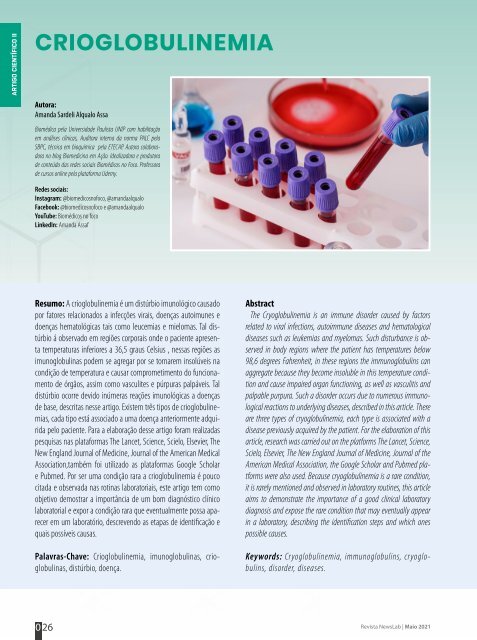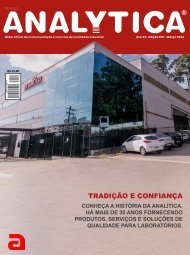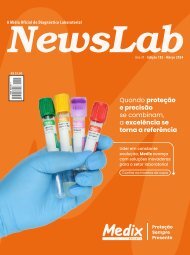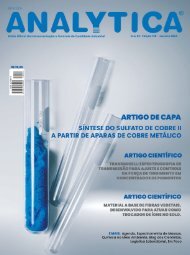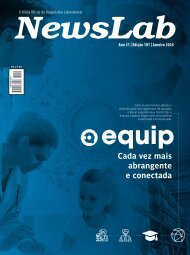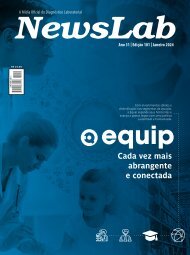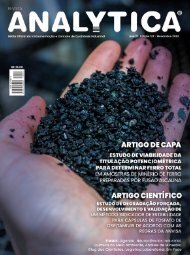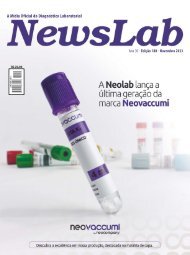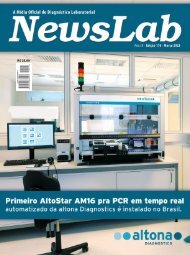Revista Newslab Edição 165
Revista Newslab Edição 165
Revista Newslab Edição 165
You also want an ePaper? Increase the reach of your titles
YUMPU automatically turns print PDFs into web optimized ePapers that Google loves.
ARTIGO CIENTÍFICO II<br />
CRIOGLOBULINEMIA<br />
Autora:<br />
Amanda Sardeli Alqualo Assa<br />
Biomédica pela Universidade Paulista UNIP com habilitação<br />
em análises clínicas, Auditora interna da norma PALC pela<br />
SBPC, técnica em bioquímica pela ETECAP. Autora colaboradora<br />
no blog Biomedicina em Ação. Idealizadora e produtora<br />
de conteúdo das redes sociais Biomédicos no Foco. Professora<br />
de cursos online pela plataforma Udemy.<br />
Redes sociais:<br />
Instagram: @biomedicosnofoco, @amandaalqualo<br />
Facebook: @biomedicosnofoco e @amandaalqualo<br />
YouTube: Biomédicos no foco<br />
LinkedIn: Amanda Assaf<br />
Resumo: A crioglobulinemia é um distúrbio imunológico causado<br />
por fatores relacionados a infecções virais, doenças autoimunes e<br />
doenças hematológicas tais como leucemias e mielomas. Tal distúrbio<br />
á observado em regiões corporais onde o paciente apresenta<br />
temperaturas inferiores a 36,5 graus Celsius , nessas regiões as<br />
imunoglobulinas podem se agregar por se tornarem insolúveis na<br />
condição de temperatura e causar comprometimento do funcionamento<br />
de órgãos, assim como vasculites e púrpuras palpáveis. Tal<br />
distúrbio ocorre devido inúmeras reações imunológicas a doenças<br />
de base, descritas nesse artigo. Existem três tipos de crioglobulinemias,<br />
cada tipo está associado a uma doença anteriormente adquirida<br />
pelo paciente. Para a elaboração desse artigo foram realizadas<br />
pesquisas nas plataformas The Lancet, Science, Scielo, Elsevier, The<br />
New England Journal of Medicine, Journal of the American Medical<br />
Association,também foi utilizado as plataformas Google Scholar<br />
e Pubmed. Por ser uma condição rara a crioglobulinemia é pouco<br />
citada e observada nas rotinas laboratoriais, este artigo tem como<br />
objetivo demostrar a importância de um bom diagnóstico clínico<br />
laboratorial e expor a condição rara que eventualmente possa aparecer<br />
em um laboratório, descrevendo as etapas de identificação e<br />
quais possíveis causas.<br />
Palavras-Chave: Crioglobulinemia, imunoglobulinas, crioglobulinas,<br />
distúrbio, doença.<br />
Abstract<br />
The Cryoglobulinemia is an immune disorder caused by factors<br />
related to viral infections, autoimmune diseases and hematological<br />
diseases such as leukemias and myelomas. Such disturbance is observed<br />
in body regions where the patient has temperatures below<br />
98,6 degrees Fahrenheit, in these regions the immunoglobulins can<br />
aggregate because they become insoluble in this temperature condition<br />
and cause impaired organ functioning, as well as vasculitis and<br />
palpable purpura. Such a disorder occurs due to numerous immunological<br />
reactions to underlying diseases, described in this article. There<br />
are three types of cryoglobulinemia, each type is associated with a<br />
disease previously acquired by the patient. For the elaboration of this<br />
article, research was carried out on the platforms The Lancet, Science,<br />
Scielo, Elsevier, The New England Journal of Medicine, Journal of the<br />
American Medical Association, the Google Scholar and Pubmed platforms<br />
were also used. Because cryoglobulinemia is a rare condition,<br />
it is rarely mentioned and observed in laboratory routines, this article<br />
aims to demonstrate the importance of a good clinical laboratory<br />
diagnosis and expose the rare condition that may eventually appear<br />
in a laboratory, describing the identification steps and which ones<br />
possible causes.<br />
Keywords: Cryoglobulinemia, immunoglobulins, cryoglobulins,<br />
disorder, diseases.<br />
0 26<br />
<strong>Revista</strong> NewsLab | Maio 2021


